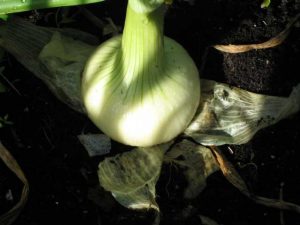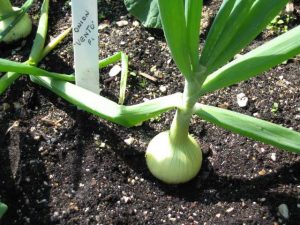Show grower John Trim has won the national championship with his onions. In this article on growing onions for show, he reveals the secrets of growing 250 gram exhibition onions to get you the winner’s red card at the show.
This class of onion is only awarded 15 points on the scale of difficulty as recorded by the RHS and the NVS . This some what understates just how difficult these onions can be to grow to National show standard. In my opinion this should be an 18 point vegetable.
Fortunately this class is not restricted to just one variety winning all the time at the top level. Several different cultivars will do the job if well grown. My current favourite and a consistent show winner is Vento. This particular onion is available from Medwyns of Anglesey. I can also recommend Toughball, Globo and Canto. All these are reliable show winners.
Sowing the Onion Seed

Onions with split skins should be peeled back to ground level but do not remove the skin completely until it dries out.
Mid to late January is the time to start off the onion seed. Fill a half size seed tray with Levington F2s seed compost, firm lightly to exclude air pockets then moisten well with warm water.
If you are using coated seed, sow this on the surface of the compost and cover with a very fine layer of vermiculite or finely sieved compost. Some people have trouble germinating coated seed because they sow it too deeply.
Place the seed tray in a propagator set at 65f /18c. Alternatively place the seed tray in a plastic bag and pop it in the airing cupboard. The seed will germinate in 7/10 days.
Pricking out Onions
The young seedlings can be pricked out using a fork when they are at the crook stage. This is just before the seed leaf straightens out. At this stage of development the young seedling will have just one central root. Prick them out into 1”/25mm plugs that are a minimum 2”/50mm deep , using Levingtons F2s compost.
Place the tray in a position of good light and maintain a minimum temperature of 50f/10c.
Potting on the Onions
After 4/5 weeks the onions should have filled the deep plugs and can then be potted on into 3”/75mm square pots using Levingtons M2 compost.
Once the roots have filled these pots which will take 3/4 weeks move them on into 5″/125mm pots using Levingtons M3 compost. As the foliage grows support with split canes and plastic clip on rings.
Growing on the Onions
The onions are grown on until planting out time which will be mid April until early May dependant on the weather. The onions are planted out 9” apart into the fertile soil of the poly tunnel which had been manured with a bag of spent mushroom compost per square meter in the autumn, plus 4oz/115grams of Vitax Q4 per square metre raked in a couple of weeks before planting out.
The ideal Ph of the soil should be in the range of 6.5/7.0. Correct any deficiency with Dolomite or ground limestone. The onions may also be grown in 7”pots using Levington M3 compost with the addition of 1lb /500 grams of dolomite lime to each bag of compost.
By June the onions will be bulbing nicely. Any with split skins should be peeled back to ground level but do not remove the skin completely until it dries out.
Lifting and ripening the Onions
Measure the circumference of the onions daily. Vento and Canto should be lifted when they reach 10.5”, trim the foliage down to 3”/75mm and cut off the roots with a sharp knife. Pop the onion on the scales to check the weight. It will not matter if it is a few grams over as they will lose a little weight with ripening. The more globe shaped onions like Globo and Toughball should be lifted at 10” circumference as they tend to have more weight.
Preparing for show.
The day before the show tie the necks of the onions with natural raffia about half an inch above the neck of the onion. This is made easier if the neck is first immersed in warm water to soften it and thus avoid splitting a skin during tying.
Trim off the surplus neck foliage to leave approximately half an inch above the tie. Wrap the onions in newspaper and transport to the show in a stout box. Arrange the onions on a black background or on sand. Consult the schedule to see what the rules allow.
After the show remove the raffia and store the onions in a dark airy room. They can then be used for further shows. If a skin puckers badly or splits it can sometimes be removed to reveal a perfect brown skin below. Allow the skin to dry for a few days before the next show.











